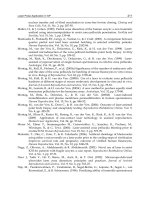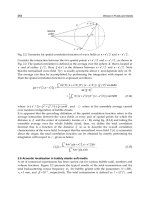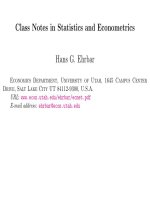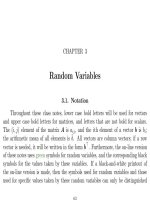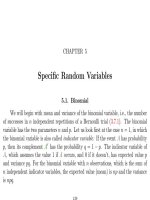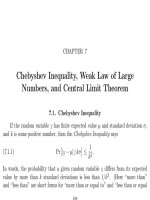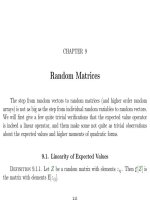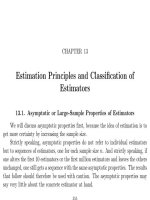Class Notes in Statistics and Econometrics Part 12 ppsx
Bạn đang xem bản rút gọn của tài liệu. Xem và tải ngay bản đầy đủ của tài liệu tại đây (462.62 KB, 46 trang )
CHAPTER 23
The Mean Squared Error as an Initial Criterion of
Precision
The question how “close” two random variables are to each other is a central
concern in statistics. The goal of statistics is to find observed random variables which
are “close” to the unobserved parameters or random outcomes of interest. These ob-
served random variables are usually called “estimators” if the unobserved magnitude
is nonrandom, and “predictors” if it is random. For scalar random variables we will
use the mean squared error as a criterion for closeness. Its definition is MSE[
ˆ
φ; φ]
(read it: mean squared error of
ˆ
φ as an estimator or predictor, whatever the case
may be, of φ):
(23.0.1) MSE[
ˆ
φ; φ] = E[(
ˆ
φ −φ)
2
]
629
630 23. THE MEAN SQUA RED ERROR AS AN INITIAL CRITERION OF PRECISION
For our purposes, therefore, the estimator (or predictor)
ˆ
φ of the unknown parameter
(or unobserved random variable) φ is no worse than the alternative
˜
φ if MSE[
ˆ
φ; φ] ≤
MSE[
˜
φ; φ]. This is a criterion which can be applied before any observations are
collected and actual estimations are made; it is an “initial” criterion regarding the
expected average performance in a series of future trials (even though, in economics,
usually only one trial is made).
23.1. Comparison of Two Vector Estimators
If one wants to compare two vector estimators, say
ˆ
φ and
˜
φ, it is often impossible
to say which of two estimators is better. It may be the case that
ˆ
φ
1
is better than
˜
φ
1
(in terms of MSE or some other criterion), but
ˆ
φ
2
is worse than
˜
φ
2
. And even if
every component φ
i
is estimated better by
ˆ
φ
i
than by
˜
φ
i
, certain linear combinations
t
φ of the components of φ may be estimated better by t
˜
φ than by t
ˆ
φ.
Problem 294. 2 points Construct an example of two vector estimators
ˆ
φ and
˜
φ of the same random vector φ =
φ
1
φ
2
, so that MSE[
ˆ
φ
i
; φ
i
] < MSE[
˜
φ
i
; φ
i
] for
i = 1, 2 but MSE[
ˆ
φ
1
+
ˆ
φ
2
; φ
1
+ φ
2
] > MSE[
˜
φ
1
+
˜
φ
2
; φ
1
+ φ
2
]. Hint: it is easiest to use
an example in which all random variables are constants. Another hint: the geometric
analog would be to find two vectors in a plane
ˆ
φ and
˜
φ. In each component (i.e.,
23.1. COMPARISON OF TWO VECTOR ESTIMATORS 631
projection on the axes),
ˆ
φ is closer to the origin than
˜
φ. But in the projection on
the diagonal,
˜
φ is closer to the origin than
ˆ
φ.
Answer. In the simplest counterexample, all variables involved are constants: φ =
0
0
,
ˆ
φ =
1
1
, and
˜
φ =
−2
2
.
One can only then say unambiguously that the vector
ˆ
φ is a no worse estimator
than
˜
φ if its MSE is smaller or equal for every linear combination. Theorem 23.1.1
will show that this is the c ase if and only if the MSE-matrix of
ˆ
φ is smaller, by a
nonnegative definite matrix, than that of
˜
φ. If this is so, then theorem 23.1.1 says
that not only the MSE of all linear transformations, but also all other nonnegative
definite quadratic loss functions involving these vectors (such as the trace of the
MSE-matrix, which is an often-used criterion) are minimized. In order to formulate
and prove this, we first need a formal definition of the MSE-matrix. We write MSE
for the matrix and MSE for the scalar mean squared error. The MSE-matrix of
ˆ
φ
as an estimator of φ is defined as
(23.1.1) MSE[
ˆ
φ; φ] =
E
[(
ˆ
φ −φ)(
ˆ
φ −φ)
] .
632 23. THE MEAN SQUA RED ERROR AS AN INITIAL CRITERION OF PRECISION
Problem 295. 2 points Let θ be a vector of possibly random parameters, and
ˆ
θ
an estimator of θ. Show that
(23.1.2) MSE[
ˆ
θ; θ] =
V
[
ˆ
θ − θ] + (
E
[
ˆ
θ − θ])(
E
[
ˆ
θ − θ])
.
Don’t assume the scalar result but make a proof that is good for vectors and scalars.
Answer. For any random vector x follows
E
[xx
] =
E
(x −
E
[x] +
E
[x])(x −
E
[x] +
E
[x])
=
E
(x −
E
[x])(x −
E
[x])
−
E
(x −
E
[x])
E
[x]
−
E
E
[x](x −
E
[x])
+
E
E
[x]
E
[x]
=
V
[x] − O − O +
E
[x]
E
[x]
.
Setting x =
ˆ
θ − θ the statement follows.
If θ is nonrandom, formula (23.1.2) simplifies slightly, since in this case
V
[
ˆ
θ−θ] =
V
[
ˆ
θ]. In this c ase , the MSE matrix is the covariance matrix plus the squared bias
matrix. If θ is nonrandom and in addition
ˆ
θ is unbiased, then the MSE-matrix
coincides with the covariance matrix.
Theorem 23.1.1. Assume
ˆ
φ and
˜
φ are two estimators of the parameter φ (which
is allowed to be random itself). Then conditions (23.1.3), (23.1.4), and (23.1.5) are
23.1. COMPARISON OF TWO VECTOR ESTIMATORS 633
equivalent:
For every constant vector t, MSE[t
ˆ
φ; t
φ] ≤ MSE[t
˜
φ; t
φ](23.1.3)
MSE[
˜
φ; φ] −MSE[
ˆ
φ; φ] is a nonnegative definite matrix(23.1.4)
For every nnd Θ, E
(
ˆ
φ −φ)
Θ(
ˆ
φ −φ)
≤ E
(
˜
φ −φ)
Θ(
˜
φ −φ)
.(23.1.5)
Proof. Call MSE[
˜
φ; φ] = σ
2
Ξ and MSE[
ˆ
φ; φ] = σ
2
Ω
Ω
Ω. To show that (23.1.3)
implies (23.1.4), simply note that MSE[t
ˆ
φ; t
φ] = σ
2
t
Ω
Ω
Ωt and likewise MSE[t
˜
φ; t
φ] =
σ
2
t
Ξt. Therefore (23.1.3) is equivalent to t
(Ξ − Ω
Ω
Ω)t ≥ 0 for all t, which is the
defining property making Ξ −Ω
Ω
Ω nonnegative definite.
Here is the proof that (23.1.4) implies (23.1.5):
E[(
ˆ
φ −φ)
Θ(
ˆ
φ −φ)] = E[tr
(
ˆ
φ −φ)
Θ(
ˆ
φ −φ)
] =
= E[tr
Θ(
ˆ
φ −φ)(
ˆ
φ −φ)
] = tr
Θ
E
[(
ˆ
φ −φ)(
ˆ
φ −φ)
]
= σ
2
tr
ΘΩ
Ω
Ω
and in the same way
E[(
˜
φ −φ)
Θ(
˜
φ −φ)] = σ
2
tr
ΘΞ
.
The difference in the expected quadratic forms is therefore σ
2
tr
Θ(Ξ − Ω
Ω
Ω)
. By
assumption, Ξ − Ω
Ω
Ω is nonnegative definite. Therefore, by theorem A.5.6 in the
Mathematical Appendix, or by Problem 296 below, this trace is nonnegative.
634 23. THE MEAN SQUA RED ERROR AS AN INITIAL CRITERION OF PRECISION
To complete the proof, (23.1.5) has (23.1.3) as a sp e cial case if one sets Θ =
tt
.
Problem 296. Show that if Θ and Σ
Σ
Σ are symmetric and nonnegative definite,
then tr(ΘΣ
Σ
Σ) ≥ 0. You are allowed to use that tr(AB) = tr(BA), that the trace of a
nonnegative definite matrix is ≥ 0, and Problem 129 (which is trivial).
Answer. Write Θ = RR
; then tr(ΘΣ
Σ
Σ) = tr(RR
Σ
Σ
Σ) = tr(R
Σ
Σ
ΣR) ≥ 0.
Problem 297. Consider two very simple-minded estimators of the unknown
nonrandom parameter vector φ =
φ
1
φ
2
. Neither of these estimators depends on any
observations, they are constants. The first estimator is
ˆ
φ = [
11
11
], and the second is
˜
φ = [
12
8
].
• a. 2 points Compute the MSE-matrices of these two estimators if the true
value of the parameter vector is φ = [
10
10
]. For which estimator is the trace of the
MSE matrix smaller?
23.1. COMPARISON OF TWO VECTOR ESTIMATORS 635
Answer.
ˆ
φ has smaller trace of the MSE-matrix.
ˆ
φ − φ =
1
1
MSE[
ˆ
φ; φ] =
E
[(
ˆ
φ − φ)(
ˆ
φ − φ)
]
=
E
[
1
1
1 1
] =
E
[
1 1
1 1
] =
1 1
1 1
˜
φ − φ =
2
−2
MSE[
˜
φ; φ] =
4 −4
−4 4
Note that both MSE-matrices are singular, i.e., both estimators allow an error-free look at cer tain
linear combinations of the parameter vector.
• b. 1 point Give two vectors g = [
g
1
g
2
] and h =
h
1
h
2
satisfying MSE[g
ˆ
φ; g
φ] <
MSE[g
˜
φ; g
φ] and MSE[h
ˆ
φ; h
φ] > MSE[h
˜
φ; h
φ] (g and h are not unique;
there are many possibilities).
Answer. With g =
1
−1
and h =
1
1
for instance we get g
ˆ
φ − g
φ = 0, g
˜
φ −
g
φ = 4, h
ˆ
φ; h
φ = 2, h
˜
φ; h
φ = 0, therefore MSE[g
ˆ
φ; g
φ] = 0, MSE[g
˜
φ; g
φ] = 16,
636 23. THE MEAN SQUA RED ERROR AS AN INITIAL CRITERION OF PRECISION
MSE[h
ˆ
φ; h
φ] = 4, MSE[h
˜
φ; h
φ] = 0. An alternative way to compute this is e.g.
MSE[h
˜
φ; h
φ] =
1 −1
4 −4
−4 4
1
−1
= 16
• c. 1 point Show that neither MSE[
ˆ
φ; φ] − MSE[
˜
φ; φ] nor MSE[
˜
φ; φ] −
MSE[
ˆ
φ; φ] is a nonnegative definite matrix. Hint: you are allowed to use the
mathematical fact that if a matrix is nonnegative definite, then its determinant is
nonnegative.
Answer.
(23.1.6) MSE[
˜
φ; φ] − MSE[
ˆ
φ; φ] =
3 −5
−5 3
Its determinant is negative, and the determinant of its negative is also negative.
CHAPTER 24
Sampling Properties of the Least Squares
Estimator
The estimator
ˆ
β was derived from a geometric argument, and everything which
we showed so far are what [DM93, p. 3] calls its numerical as opposed to its statistical
prop e rties. But
ˆ
β has also nice statistical or sampling prop e rties. We are assuming
right now the specification given in (18.1.3), in which X is an arbitrary matrix of full
column rank, and we are not assuming that the errors must b e Normally distributed.
The assumption that X is nonrandom means that repeated samples are taken with
the same X-matrix. This is often true for expe rimental data, but not in econometrics.
The sampling properties which we are really interested in are those where also the X-
matrix is random; we will derive those later. For this later derivation, the properties
637
638 24. SAMPLING PROPERTIES OF THE LEAST SQUARES ESTIMATOR
with fixed X-matrix, which we are going to discuss presently, will be needed as an
intermediate step. The assumption of fixed X is therefore a preliminary technical
assumption, to be dropped later.
In order to know how good the estimator
ˆ
β is, one needs the statistical properties
of its “sampling error”
ˆ
β − β. This sampling error has the following formula:
ˆ
β − β = (X
X)
−1
X
y − (X
X)
−1
X
Xβ =
= (X
X)
−1
X
(y − Xβ) = (X
X)
−1
X
ε
ε
ε(24.0.7)
From (24.0.7) follows immediately that
ˆ
β is unbiased, since
E
[(X
X)
−1
X
ε
ε
ε] = o.
Unbiasedness does not make an estimator be tter, but many good estimators are
unbiased, and it simplifies the math.
We will use the MSE-matrix as a criterion for how good an estimator of a vector
of unobserved parameters is. Chapter 23 gave some reasons why this is a sensible
criterion (compare [DM93, Chapter 5.5]).
24.1. THE GAUSS MARKOV THEOREM 639
24.1. The Gauss Markov Theorem
Returning to the least squares estimator
ˆ
β, one obtains, using (24.0.7), that
MSE[
ˆ
β; β] =
E
[(
ˆ
β − β)(
ˆ
β − β)
] = (X
X)
−1
X
E
[ε
ε
εε
ε
ε
]X(X
X)
−1
=
= σ
2
(X
X)
−1
.(24.1.1)
This is a very simple formula. Its most interesting aspect is that this MSE matrix
does not depend on the value of the true β. In particular this means that it is
bounded with respect to β, which is important for someone who wants to be assured
of a certain accuracy even in the worst possible situation.
Problem 298. 2 points Compute the MSE-matrix MSE[ˆε;ε
ε
ε] =
E
[(ˆε −ε
ε
ε)(ˆε −
ε
ε
ε)
] of the residuals as predictors of the disturbances.
Answer. Write ˆε − ε
ε
ε = Mε
ε
ε − ε
ε
ε = (M − I)ε
ε
ε = −X(X
X)
−1
X
ε
ε
ε; therefore MSE[ˆε; ε
ε
ε] =
E
[X(X
X)
−1
X
ε
ε
εε
ε
ε
X(X
X)
−1
X = σ
2
X(X
X)
−1
X
. Alternatively, start with ˆε − ε
ε
ε = y −
ˆy−ε
ε
ε = Xβ−ˆy = X(β−
ˆ
β). This allows to use MSE[ˆε; ε
ε
ε] = X MSE[
ˆ
β; β]X
= σ
2
X(X
X)
−1
X
.
Problem 299. 2 points Let v be a random vector that is a linear transformation
of y, i.e., v = T y for some constant matrix T . Furthermore v satisfies
E
[v] = o.
Show that from this follows v = T ˆε. (In other words, no other transformation of y
with zero expected value is more “comprehensive” than ε
ε
ε. However there are many
640 24. SAMPLING PROPERTIES OF THE LEAST SQUARES ESTIMATOR
other transformation of y with zero expected value which are as “comprehensive” as
ε
ε
ε).
Answer.
E
[v] = T Xβ must be o whatever the value of β. Therefore T X = O, from which
follows T M = T . Since ˆε = My, this gives immediately v = T ˆε. (This is the statistical implication
of the mathematical fact that M is a defi cien cy matrix of X.)
Problem 300. 2 points Show that
ˆ
β and ˆε are uncorrelated, i.e., cov[
ˆ
β
i
, ˆε
j
] =
0 for all i, j. Defining the covariance matrix
C
[
ˆ
β, ˆε] as that matrix whose (i, j)
element is cov[
ˆ
β
i
, ˆε
j
], this can also be written as
C
[
ˆ
β, ˆε] = O. Hint: The covariance
matrix satisfies the rules
C
[Ay, Bz] = A
C
[y, z]B
and
C
[y, y] =
V
[y]. (Other rules
for the covariance matrix, which will not be needed here, are
C
[z, y] = (
C
[y, z])
,
C
[x + y, z] =
C
[x, z] +
C
[y, z],
C
[x, y + z] =
C
[x, y] +
C
[x, z], an d
C
[y, c] = O if c is
a vector of constants.)
Answer. A = (X
X)
−1
X
and B = I−X(X
X)
−1
X
, therefore
C
[
ˆ
β, ˆε] = σ
2
(X
X)
−1
X
(I−
X(X
X)
−1
X
) = O.
Problem 301. 4 points Let y = Xβ +ε
ε
ε be a regression model with intercept, in
which the first column of X is the vector ι, and let
ˆ
β the least squares estimator of
β. Show that the covariance matrix between ¯y and
ˆ
β, which is defined as the matrix
24.1. THE GAUSS MARKOV THEOREM 641
(here consisting of one row only) that contains all the covariances
(24.1.2)
C
[¯y,
ˆ
β] ≡
cov[¯y,
ˆ
β
1
] cov[¯y,
ˆ
β
2
] ··· cov[¯y,
ˆ
β
k
]
has the following form:
C
[¯y,
ˆ
β] =
σ
2
n
1 0 ··· 0
where n is the number of ob-
servations. Hint: That the regression has an intercept term as first column of the
X-matrix means that Xe
(1)
= ι, where e
(1)
is the unit vector having 1 in the first
place and zeros elsewhere, and ι is the vector which has ones everywhere.
Answer. Write both ¯y and
ˆ
β in terms of y, i.e., ¯y =
1
n
ι
y and
ˆ
β = (X
X)
−1
X
y. Therefore
(24.1.3)
C
[¯y,
ˆ
β] =
1
n
ι
V
[y]X(X
X)
−1
=
σ
2
n
ι
X(X
X)
−1
=
σ
2
n
e
(1)
X
X(X
X)
−1
=
σ
2
n
e
(1)
.
Theorem 24.1.1. Gauss-Markov Theorem:
ˆ
β is the BLUE (Best Linear Unbi-
ased Estimator) of β in the following vector sense: for every nonrandom coefficient
vector t, t
ˆ
β is the scalar BLUE of t
β, i.e., every other linear unbiased estimator
˜
φ = a
y of φ = t
β has a bigger MSE than t
ˆ
β.
Proof. Write the alternative linear estimator
˜
φ = a
y in the form
˜
φ =
t
(X
X)
−1
X
+ c
y(24.1.4)
642 24. SAMPLING PROPERTIES OF THE LEAST SQUARES ESTIMATOR
then the sampling error is
˜
φ −φ =
t
(X
X)
−1
X
+ c
(Xβ + ε
ε
ε) −t
β
=
t
(X
X)
−1
X
+ c
ε
ε
ε + c
Xβ.(24.1.5)
By assumption, the alternative estimator is unbiased, i.e., the expected value of this
sampling error is zero regardless of the value of β. This is only possible if c
X = o
.
But then it follows
MSE[
˜
φ; φ] = E[(
˜
φ −φ)
2
] = E[
t
(X
X)
−1
X
+ c
ε
ε
εε
ε
ε
X(X
X)
−1
t + c
] =
= σ
2
t
(X
X)
−1
X
+ c
X(X
X)
−1
t + c
= σ
2
t
(X
X)
−1
t + σ
2
c
c,
Here we needed again c
X = o
. Clearly, this is minimized if c = o, in which case
˜
φ = t
ˆ
β.
Problem 302. 4 points Show: If
˜
β is a linear unbiased estimator of β and
ˆ
β is
the OLS estimator, then the difference of the MSE-matrices MSE[
˜
β; β]− MSE[
ˆ
β; β]
is nonnegative definite.
Answer. (Compare [DM93, p. 159].) Any other linear estimator
˜
β of β can be written
as
˜
β =
(X
X)
−1
X
+ C
y. Its expected value is
E
[
˜
β] = (X
X)
−1
X
Xβ + CXβ. For
˜
β to be unbiased, regardless of the value of β, C must satisfy CX = O . But then it follows
24.2. DIGRESSION ABOUT MINIMAX ESTIMATORS 643
MSE[
˜
β; β] =
V
[
˜
β] = σ
2
(X
X)
−1
X
+ C
X(X
X)
−1
+ C
= σ
2
(X
X)
−1
+ σ
2
CC
, i.e.,
it exceeds the MSE-matrix of
ˆ
β by a nonnegative de finit e matrix.
24.2. Digression about Minimax Estimators
Theorem 24.1.1 is a somewhat puzzling property of the least squares estimator,
since there is no reason in the world to restrict one’s search for good estimators
to unbiased estimators. An alternative and more enlightening characterization of
ˆ
β does not use the concept of unbiasedness but that of a minimax estimator with
respect to the MSE. For this I am proposing the following definition:
Definition 24.2.1.
ˆ
φ is the linear minimax estimator of the scalar parameter φ
with respect to the MSE if and only if for e very other linear estimator
˜
φ there exists
a value of the parameter vector β
0
such that for all β
1
(24.2.1) MSE[
˜
φ; φ|β = β
0
] ≥ MSE[
ˆ
φ; φ|β = β
1
]
In other words, the worst that can happen if one uses any other
˜
φ is worse than
the worst that can happen if one uses
ˆ
φ. Using this concept one can prove the
following:
Theorem 24.2.2.
ˆ
β is a linear minimax est imator of the parameter vector β
in the following sense: for every nonrandom coefficient vector t, t
ˆ
β is the linear
644 24. SAMPLING PROPERTIES OF THE LEAST SQUARES ESTIMATOR
minimax estimator of the sca lar φ = t
β with respect to the MSE. I.e., for every
other linear estimator
˜
φ = a
y of φ one can find a value β = β
0
for which
˜
φ has a
larger MSE than the largest possible MSE of t
ˆ
β.
Proof: as in the proof of Theorem 24.1.1, write the alternative linear estimator
˜
φ in the form
˜
φ =
t
(X
X)
−1
X
+ c
y, so that the sampling error is given by
(24.1.5). Then it follows
(24.2.2)
MSE[
˜
φ; φ] = E[(
˜
φ−φ)
2
] = E[
t
(X
X)
−1
X
+c
ε
ε
ε+c
Xβ
ε
ε
ε
X(X
X)
−1
t+c
+β
X
c
]
(24.2.3) = σ
2
t
(X
X)
−1
X
+ c
X(X
X)
−1
t + c
+ c
Xββ
X
c
Now there are two cases : if c
X = o
, then MSE[
˜
φ; φ] = σ
2
t
(X
X)
−1
t + σ
2
c
c.
This does not depend on β and if c = o then this MSE is larger than that for c = o.
If c
X = o
, then MSE[
˜
φ; φ] is unbounded, i.e., for any finite number ω one one
can always find a β
0
for which MSE[
˜
φ; φ] > ω. Since MSE[
ˆ
φ; φ] is bounded, a β
0
can be found that satisfies (24.2.1).
24.3. MISCELLANEOUS PROPERTIES OF THE BLUE 645
If we characterize the BLUE as a minimax estimator, we are using a consistent
and unified principle. It is based on the concept of the MSE alone, not on a mix-
ture between the concepts of unbiasedness and the MSE. This explains why the
mathematical theory of the least squares estimator is so rich.
On the other hand, a minimax strategy is not a good estimation strategy. Nature
is not the adversary of the researcher; it does not maliciously choos e β in such a way
that the researcher will be misled. This explains why the least squares principle,
despite the beauty of its mathematical theory, does not give terribly good estimators
(in fact, they are inadmissible, see the Section about the Stein rule below).
ˆ
β is therefore simultaneously the solution to two very different minimization
problems. We will refer to it as the OLS estimate if we refer to its property of
minimizing the sum of squared errors, and as the BLUE estimator if we think of it
as the best linear unbiased estimator.
Note that even if σ
2
were known, one could not get a better linear unbiased
estimator of β.
24.3. Miscellaneous Properties of the BLUE
Problem 303.
646 24. SAMPLING PROPERTIES OF THE LEAST SQUARES ESTIMATOR
• a. 1 point Instead of (18.2.22) one sometimes sees the formula
(24.3.1)
ˆ
β =
(x
t
− ¯x)y
t
(x
t
− ¯x)
2
.
for the slope parameter in the simple regression. Show that these formulas are math-
ematically equivalent.
Answer. Equivalence of (24.3.1) and (18.2.22) follows from
(x
t
− ¯x) = 0 and therefore also
¯y
(x
t
− ¯x) = 0. Alternative proof, using matrix no tati on and the matrix D defined in Problem
189: (18.2.22) is
x
D
Dy
x
D
Dx
and (24.3.1) is
x
Dy
x
D
Dx
. They are equal because D is symmetric and
idempote nt.
• b. 1 point Show that
(24.3.2) var[
ˆ
β] =
σ
2
(x
i
− ¯x)
2
Answer. Write (24.3.1) as
(24.3.3)
ˆ
β =
1
(x
t
− ¯x)
2
(x
t
− ¯x)y
t
⇒ var[
ˆ
β] =
1
(x
t
− ¯x)
2
2
(x
t
− ¯x)
2
σ
2
24.3. MISCELLANEOUS PROPERTIES OF THE BLUE 647
• c. 2 points Show that cov[
ˆ
β, ¯y] = 0.
Answer. This is a special case of problem 301, but it can be easily shown here separately:
cov[
ˆ
β, ¯y] = cov
s
(x
s
− ¯x)y
s
t
(x
t
− ¯x)
2
,
1
n
j
y
j
=
1
n
t
(x
t
− ¯x)
2
cov
s
(x
s
− ¯x)y
s
,
j
y
j
=
=
1
n
t
(x
t
− ¯x)
2
s
(x
s
− ¯x)σ
2
= 0.
• d. 2 points Using (18.2.23) show that
(24.3.4) var[ˆα] = σ
2
1
n
+
¯x
2
(x
i
− ¯x)
2
Problem 304. You have two data vectors x
i
and y
i
(i = 1, . . . , n), and the true
model is
(24.3.5) y
i
= βx
i
+ ε
i
where x
i
and ε
i
satisfy the basic assumptions of the linear regression model. The
least squares estimator for this model is
(24.3.6)
˜
β = (x
x)
−1
x
y =
x
i
y
i
x
2
i
648 24. SAMPLING PROPERTIES OF THE LEAST SQUARES ESTIMATOR
• a. 1 point Is
˜
β an unbiased estimator of β? (Proof is required.)
Answer. First derive a nice expression for
˜
β −β:
˜
β −β =
x
i
y
i
x
2
i
−
x
2
i
β
x
2
i
=
x
i
(y
i
− x
i
β)
x
2
i
=
x
i
ε
i
x
2
i
since y
i
= βx
i
+ ε
i
E[
˜
β −β] = E
x
i
ε
i
x
2
i
=
E[x
i
ε
i
]
x
2
i
=
x
i
E[ε
i
]
x
2
i
= 0 since E ε
i
= 0.
• b. 2 points Derive the variance of
˜
β. (Show your work.)
24.3. MISCELLANEOUS PROPERTIES OF THE BLUE 649
Answer.
var
˜
β = E[
˜
β −β]
2
= E
x
i
ε
i
x
2
i
2
=
1
(
x
2
i
)
2
E[
x
i
ε
i
]
2
=
1
(
x
2
i
)
2
E
(x
i
ε
i
)
2
+ 2 E
i<j
(x
i
ε
i
)(x
j
ε
j
)
=
1
(
x
2
i
)
2
E[x
i
ε
i
]
2
since the ε
i
’s are uncorrelated, i.e., cov[ε
i
, ε
j
] = 0 for i = j
=
1
(
x
2
i
)
2
σ
2
x
2
i
since all ε
i
have equal variance σ
2
=
σ
2
x
2
i
.
650 24. SAMPLING PROPERTIES OF THE LEAST SQUARES ESTIMATOR
Problem 305. We still assume (24.3.5) is the true model. Consider an alter-
native estimator:
(24.3.7)
ˆ
β =
(x
i
− ¯x)(y
i
− ¯y)
(x
i
− ¯x)
2
i.e., the estimator which would be the best linear unbiased estimator if the true model
were (18.2.15).
• a. 2 points Is
ˆ
β still an unbiased estimator of β if (24.3.5) is the true model?
(A short but rigorous argument may save you a lot of algebra here).
24.3. MISCELLANEOUS PROPERTIES OF THE BLUE 651
Answer. One can argue it:
ˆ
β is unbiased for model (18.2.15) whatever the value of α or β,
therefore also when α = 0, i.e., when the model is (24.3.5). But here is the pedestrian way:
ˆ
β =
(x
i
− ¯x)(y
i
− ¯y)
(x
i
− ¯x)
2
=
(x
i
− ¯x)y
i
(x
i
− ¯x)
2
since
(x
i
− ¯x)¯y = 0
=
(x
i
− ¯x)(βx
i
+ ε
i
)
(x
i
− ¯x)
2
since y
i
= βx
i
+ ε
i
= β
(x
i
− ¯x)x
i
(x
i
− ¯x)
2
+
(x
i
− ¯x)ε
i
(x
i
− ¯x)
2
= β +
(x
i
− ¯x)ε
i
(x
i
− ¯x)
2
since
(x
i
− ¯x)x
i
=
(x
i
− ¯x)
2
E
ˆ
β = E β + E
(x
i
− ¯x)ε
i
(x
i
− ¯x)
2
= β +
(x
i
− ¯x) E
ε
i
(x
i
− ¯x)
2
= β since E ε
i
= 0 for all i, i. e.,
ˆ
β is unbiased.
• b. 2 points Derive the variance of
ˆ
β if (24.3.5) is the true model.
652 24. SAMPLING PROPERTIES OF THE LEAST SQUARES ESTIMATOR
Answer. One can again argue it: since the formula for var
ˆ
β does not depend on what the
true value of α is, it is the same formula.
var
ˆ
β = var
β +
(x
i
− ¯x)ε
i
(x
i
− ¯x)
2
(24.3.8)
= var
(x
i
− ¯x)ε
i
(x
i
− ¯x)
2
(24.3.9)
=
(x
i
− ¯x)
2
var ε
i
(
(x
i
− ¯x)
2
)
2
since cov[ε
i
ε
j
] = 0(24.3.10)
=
σ
2
(x
i
− ¯x)
2
.(24.3.11)
• c. 1 point Still assuming (24.3.5) is the true model, would you prefer
ˆ
β or the
˜
β from Problem 304 as an estimator of β?
Answer. Since
˜
β and
ˆ
β are both unbiased estimators, if (24.3.5) is the true model, the pre-
ferred estimator is the one with the smaller variance. As I will show, var
˜
β ≤ var
ˆ
β and, therefore,
˜
β is preferred to
ˆ
β. To show
var
ˆ
β =
σ
2
(x
i
− ¯x)
2
≥
σ
2
x
2
i
= var
˜
β(24.3.12)
24.3. MISCELLANEOUS PROPERTIES OF THE BLUE 653
one must show
(x
i
− ¯x)
2
≤
x
2
i
(24.3.13)
which is a simple consequence of (12.1.1). Thus var
ˆ
β ≥ var
˜
β; the variances are equal only if ¯x = 0,
i.e., if
˜
β =
ˆ
β.
Problem 306. Suppose the true model is (18.2.15) and the basic assumptions
are satisfied.
• a. 2 points In this situation,
˜
β =
x
i
y
i
x
2
i
is generally a biased estimator of β.
Show that its bias is
(24.3.14) E[
˜
β − β] = α
n¯x
x
2
i

